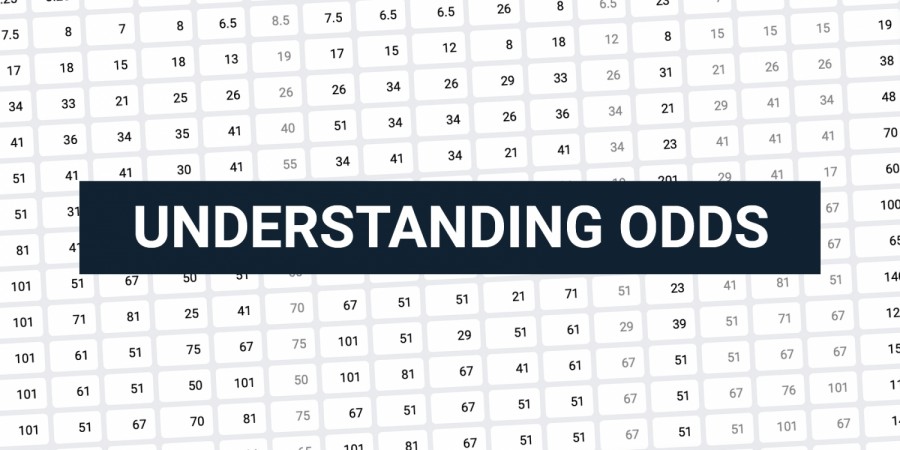How To Determine Odds In Betting
Jan 31, 2021 Betting Odds Favourable Tips. Tottenham to win @ 2.25. It goes without saying that Son’s output on Sunday will determine how many points Tottenham will take away from the Amex Stadium. To calculate winnings on fractional odds, multiply your bet by the top number (numerator), then divide the result by the bottom (denominator). So a $10 bet at 5/2 odds is (10. 5) / 2, which equals $25. A $10 bet at 2/5 odds is (10. 2) / 5, which is $4. What is Implied Probability?
- Decimal Style Sports Betting Odds Decimal style odds are used mostly in Europe, and are pretty easy to understand. To calculate the decimal style odds all you will need to do is simply multiply the amount you wish to wager by the decimal odds shown and you will get your payout. For example it may look something like this.
- So the Decimal odds for a coin being heads is 1 (certainty) divided by the probability of it occurring which we know is 0.5, producing decimal odds of 2.0. At this point you can equally take odds and reverse engineer the implied probability with the inverse of the equation for turning probability into odds: 1/decimal odds = probability.
When you're thinking about where to place your sporting wagers, it's usually best to research a few sites to find at which site you can obtain the best sign up bonuses, are user friendly and can abtain the most favourable odds, as not every wagering portal will give you the same odds. To compreheand betting odds, all you need to know is that basicall, the better odds you can obtain, the more money you will win if your bet is successful. However, not all sites will give their odds in the same format, and when it comes to calculating sports betting odds, you are going to need to familiarise yourself with all three systems.
If you are american it may take you longer to find the right site, as many sites will not work with americans and american IPs. here is a list of highly rated sport gameing sites that work with americans
How To Calculate Odds When Betting

Fraction/Ratio

This is the traditional way of representing odds. They are in the form of a ratio, or fraction, such as 6/1, 9/2 or 5/4. You can work out how 'fancied' a competitor or team is by dividing the first number in the ratio by the second – the smaller the result, the more fancied the competitor or team. If the number on the right hand side of the dividing line is larger than the number on the left, then the competitor or team is said to be 'odds-on', which means that are much more fancied to be the winner in their event, than the loser. If you back a winner, to work out your winnings, just multiply your stake by the first number in the ration, divide it by the season, then add on your original stake. For example if you back at horse at at £10 at 9/2 and it wins, you get back (10 x 9 = 90 ÷ 2 = 45 + 10 =) £55.
Decimal
Decimals are becoming increasing popular with sports-betting sites, particularly with younger punters, as they are easier to calculate. The important number when dealing with calculating sports betting odds using decimals is 2.00. This is the equivalent to the fraction/ratio odds value of 'evens' – which means a bookmaker thinks there's an exact 50:50 chance of the competitor being the winner. Decimal odds less than 2.00 are 'odds on'. To calculate your winnings with decimal odds you just multiply your stake by the odds. 9/2 in decimal odds is 5.50, so in the example above £10 x 5.50 gives £55. To convert from fraction/ratio odds to decimal just divide the first number by the second and add 1.

American Odds
The final thing you have to work out when calculating sports betting odds is American odds. These are giving in the form +100 (evens, or 2.0) or -150 (2/3, or 1.67). If the sign in front of the number is a negative sign, it means that the competitor is odds on. American odds show how much will be won if you placed $100 on a wager (if positive) or how much you need to wager to win $100 (if negative). To work out your winnings, for positive odds multiply your wager by the odds then divide it by 100 and add your stake, so $10 at +450 = (10 x 450 = 4500 ÷ 100 = 45 + 10 =) $55. For negative odds, multiply your stake by 100 then divide by the price and add your stake, so $10 at -250 = (10 x 100 = 1000 ÷ 250 = 4 + 10 =) $14.
Need Help?
If you're getting stuck in calculating sports betting odds, then the good news is there are plenty of software tools out there to get you up and running. One of the leader runners is called the Z-Code System, which is a complete sports-betting software package that analyses dozens of attributes concerning nearly all of the major sporting contests, and in doing so does most of the homework for you. If you're struggling with calculating sports betting odds, and who want all the best sports betting information at your fingertips, you out to consider taking the Z-Code system out for a spin.
Betting Odds Meanings
Sometimes it is necessary to figure out the average odds from a set of betting odds which can then be used as the basis for further calculations. For example, computing deviation and variance.
When using odds in European format (decimal) you can be forgiven for thinking that average betting odds are simply computed by building the arithmetic mean of the data to be analysed. Unfortunately, this is the wrong approach and leads to a deceptive result.
As a reminder, European odds are calculated as the reciprocal of the statistical probabilities of each event:
and vice versa … The implied probabilities are the reciprocals of the odds:
In effect, European odds are ratios/relations representing the likelihood of an event happening in comparison to each other event (e.g. a bet priced at odds of 4.0 is half as likely to win as a bet with odds of 2.0).
If these ratios are averaged using arithmetic mean (a common error), high data points are given greater weights than low data points. (e.g. working out the arithmetic mean of a set of 20 odds, 19 of them between 2.0 and 2.4, would be skewed if the 20th figure was, say, 15.0).
The correct approach is to calculate average odds by forming the harmonic mean!
The harmonic mean is defined as the reciprocal of the arithmetic mean of the reciprocals of x1, x2, …, xn (the odds):

As the reciprocals of betting odds are the implied probabilities of the events, one can calculate the harmonic mean as a reciprocal of the average probability of the respective bets:
How To Count Odds In Betting
The above equations rearranged facilitates the harmonic mean calculation by dividing n (the number of matches) by the sum of the reciprocals of the odds:
How To Determine Winning Odds In Soccer Betting
Or alternatively… dividing n (the number of matches) by the sum of their individual probabilities:
The Result (Harmonic Mean) is the Accurate Average of the Betting Odds.
How To Determine Probability
Excel users employ the following formula: =HARMEAN(number1,number2,…)